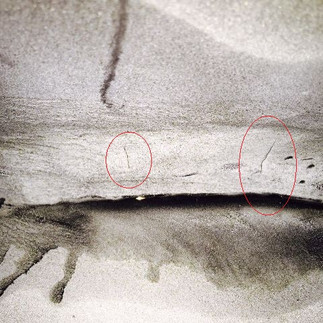Welcome to Our Blog, Prohull Asia - value engineering!
Magnetic particle inspection (MPI) is a non-destructive testing (NDT) technique commonly used in welding to detect surface and subsurface defects in welds. MPI is a highly effective technique for detecting flaws such as cracks, porosity, inclusions, and lack of fusion in welds. In this article, we will explore the principles and benefits of MPI on welds.
Cracks were revealed after MT to welds of a Bulk Carrier (Copyright © Prohull Asia, 2023)
The principles of MPI involve using a magnetic field and magnetic particles to detect surface and subsurface defects. The principle of magnetism is used to magnetize the component being inspected. Once the component is magnetized, magnetic particles are applied to the surface of the weld. The magnetic particles are attracted to areas of magnetic flux leakage caused by defects in the weld. These areas are visible under a black light, making it easy to detect the location and size of the defect.

MT is in progress on the fillet welds of longitudinal stiffeners (Copyright ©, 2023)
MPI is a highly sensitive and reliable method for detecting defects in welds. It is also a relatively quick and cost-effective method compared to other NDT techniques. MPI can be used to inspect a wide range of weld types, including fillet, butt, and groove welds.
MPI is particularly useful for welds that are difficult to access or have complex geometries. It is also useful for welds subject to high loads or stresses, as defects in these areas can be particularly dangerous and difficult to detect using other methods.
One of the key benefits of MPI is that it is a non-destructive technique, meaning that the component being inspected is not damaged or altered in any way during the inspection process. This is particularly important for welded components that need to maintain their structural integrity.
MPI can also be used to inspect components in real-time, allowing defects to be detected and repaired quickly, reducing downtime and costs. This is particularly useful for industries such as oil and gas, where downtime can be extremely costly.
MPI also has a high level of accuracy and repeatability, meaning that results can be reproduced and verified with confidence. This is important for industries such as aerospace and automotive, where safety and reliability are critical factors.
In conclusion, MPI is a highly effective and reliable NDT technique for detecting defects in welds. Its non-destructive nature, speed, and accuracy make it an invaluable tool for industries such as oil and gas, aerospace, and automotive. MPI can also be used to inspect components in real-time, allowing defects to be detected and repaired quickly, reducing downtime and costs. Companies that require MPI on their welds should choose reputable firms with experienced technicians to ensure accurate and reliable results.
COPYRIGHT WARNING AND INFORMATION: For requests to use copyright-protected work in any manner, email prohullasia@prohullasia.com







